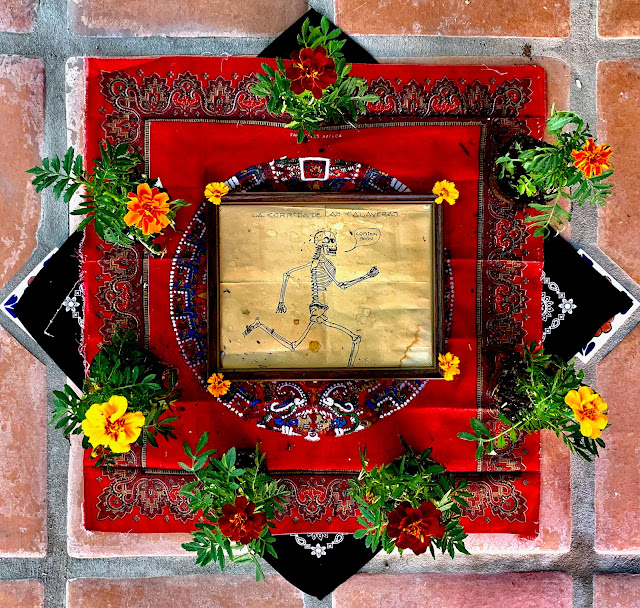Xochimikeh:
Flowering of the Ancestors
There is a day, one
of twenty in the Tonal Machiotl (Aztec Calendar) that is Mikiztli, a skull
representing not death as ending but as the seed of Life. Every 20 days our
ancestors honored “those who have been offered to the Spirit world” or
Xochimikeh.
There was also a time when a community honored all Xochimikeh.
During these “Days of the Dead” the different deceased were honored in a
special way: the children, elders, adults, women who died in childbirth, and
warriors. This is the festival of Xochimikeh, carried on when the count of 13
(the Aztec Calendar counts only goes up to 13 then back to one) matched the
Micailhuitl or Mikiztli (day of the Dead). This happens every 260 days, the
amount of human gestational period marked by the cycle of Venus from Evening to
Morning Star, the nine Moon cycles of 28 days, and the nine special orbital
points between Earth and Sun.
When the Spaniards
invaded Anahuak, they banned all Nahuatlaca ceremony unless it was done within
a Catholic context. Centuries earlier, the Holy Roman Empire that succeeded in
defeating the Celtic Confederation, forcing them to accept Christianity. In
this transition, they allowed the Celtic honoring of the dead to continue but
as all Saints and all Souls days. The Celts conducted this ceremony at the end
of October (October 31 through Novemeber 2), as part of their harvest festival.
As the Anahuacas were forced to celebrate their ceremony as Catholics, we
transferred the customs and protocols of Xochimikeh to all Saints and all Souls
days and called them Dias de los Muertos.
While the Mexica ceremony is very similar to the ancient one, the dates are different. This year the days of the dead will be during 13-Eagle and 1-Condor. The next match of 13-Mikiztli will be on December 2, 2021.
Hay un día, uno de los veinte en el Tonal
Machiotl (Calendario Azteca) que es Mikiztli, una calabera representando no a
la muerte sino a la semilla de Vida. Cada 20 días nuestros ancesotros honraban
a “aquellos quienes se habían ofrendado al mundo de los Espíritus” ó
Xochimikeh. Había también un tiempo cuando una comunidad honraba a todos los
Xochimikeh. Durante éstos días “Días de la Muerte” los diferentes tipos de
muertes eran honrados de una manera especial: Los(las) niños(niñas), los(las)
ancianos(as), adultos, mujeres que morían durante el parto, y los(las)
guerreros(as).
Este es el festival de Xochimikeh, llevado a cabo cuando la
cuenta de 13 (la cuenta del Calendario Azteca sólo va hasta el 13 y de ahí se
regresa al uno) emparejando a Micailhuitl ó a Mikiztli (día de los Muertos).
Esto sucede cada 260 días, la cantidad del período de gestación humana marcado
por el cíclo de Venus cuando pasa de ser la Esterlla de la Tarde a ser la
Estrella de la Mañana, los nueve cíclos Lunares de 28 días y los nueve puntos
especiales orvitales entre la Tierra y el Sol.
Cuando los españoles invadieron el Anahuak, ellos prohibieron toda ceremonia Nahuatlaca a menos que fuera hecha dentro del contexto católico. Siglos antes, El Santo Imperio Romano que triunfara en vencer a la Confederación Celta, fueron forzados a aceptar la cristianidad. En esta transición, les permitieron a los Celtas honrar a los muertos pero como “Todos los Santos” y “el Día de las Almas”. Los Celtas conducían esta ceremonia al final de Octubre (del 31 de Octubre hasta el 2 de Noviembre) como parte de su festival de la cosecha. Así mismo, los Anahuacas fueron forzados a celebrar su ceremonia como católica, transferimos las costumbres y protocolos de Xochimikeh a los Días de Todos los Santos y de las Almas y le llamamos Día de los Muertos.
Mientras que la ceremonia Mexica es muy similar a la antigua, las fechas son diferentes. Este año los Días de la Muerte serán durante 13-Aguila y 1-Condor. El siguiente emparejamiento de 13-Mikiztli será el 2 de Diciember, 2021.
Carlos Aceves Yolohuitzcalotl
Chicnahui Calli
Xihuitl
IZKALOTEKA
...No somos turistas en la tierra...
La Corrida de las Calaveras
Traditional Barrio Run
Dawn – Almanecer
Domingo 31 octubre 2021






